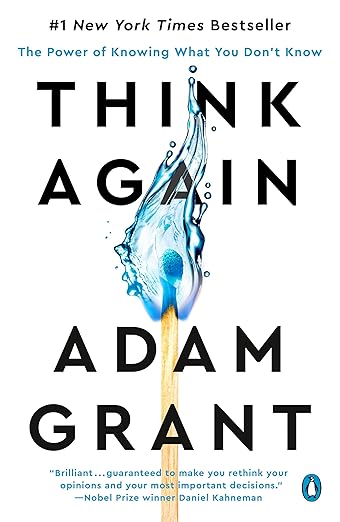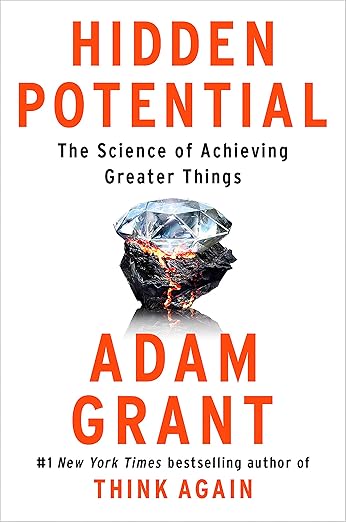Give and Take
A groundbreaking look at why our interactions with others hold the key to success, from the bestselling author of Originals. For generations, we have focused on the individual drivers of success: passion, hard work, talent, and luck. But in today’s dramatically reconfigured world, success is increasingly dependent on how we interact with others. In Give and Take, Adam Grant, an award-winning researcher and Wharton’s highest-rated professor, examines the surprising forces that shape why some people rise to the top of the success ladder while others sink to the bottom. Praised by social scientists, business theorists, and corporate leaders, Give and Take opens up an approach to work, interactions, and productivity that is nothing short of revolutionary...
How can you read this book?
Click these simple buttons to read this book today.
You may like these books... Buy now!

|

|

|
Adam Grant, Author ![]()
Bridging the Gap Between Psychology and Productivity
Adam M. Grant, born on August 13, 1981, in West Bloomfield, Michigan, is a renowned American organizational psychologist, bestselling author, and professor at the Wharton School of the University of Pennsylvania. His groundbreaking work in organizational psychology has not only made him a top-rated professor but has also positioned him as a thought leader in the realms of workplace dynamics and management.
Early Life and Education: Growing up in the suburbs of Detroit, Michigan, Grant displayed early prowess in springboard diving and nurtured dreams of becoming a professional basketball player. He earned a B.A. from Harvard College and pursued further studies at the University of Michigan, where he obtained M.S. and Ph.D. degrees in organizational psychology. Grant's eclectic background includes a stint as a professional magician during his college years.
Academic and Professional Journey: Before delving into academia, Grant served as the advertising director at Let's Go Publications and showcased his skills as a professional magician. His academic career began at the University of North Carolina at Chapel Hill, where he assumed the role of assistant professor of organizational behavior in 2007. Notably, he transitioned to the Wharton School of the University of Pennsylvania in 2009 and achieved the distinction of becoming the school's youngest-tenured professor at the age of 28.
Grant's impact in the academic realm is underscored by his consistent recognition as the best professor at the University of Pennsylvania from 2011 to 2017, as rated by students. His expertise extends beyond traditional academia, as he co-founded Give and Take, Inc., a company focused on implementing the principles from his book "Give and Take" through innovative software called Givitas.
Author and Podcaster: Adam Grant's influence extends to popular science writing, and he has authored several bestselling books that explore topics such as motivation, generosity, creativity, and potential. His works have been translated into 45 languages, reaching a global audience. As the host of podcasts like "WorkLife" and "ReThinking," Grant continues to share insights and engage with audiences on critical aspects of work and life.
Personal Life: In his personal life, Grant is married to Allison, and the couple is blessed with two daughters and a son. Beyond his academic and professional achievements, Adam Grant's journey reflects a commitment to bridging the gap between psychology and productivity, inspiring individuals and organizations to rethink assumptions and unlock their full potential.
Reviewed in the United States on April 17, 2013
The premise of the book is quite simple: the world comprises three types of people: givers, takers and matchers. Which type tends to be most successful? Although we've all been raised on the homily that it's better to give than to receive, the bad news is that the left side of most bell curves is populated by givers, those who contribute more to others than they expect in return. Quite simply, they do less for themselves, people take advantage of them, and they are prone to burnout.
But the real surprise is that the right side of bell curves is also a givers' neighborhood. Combining extensive research with inspiring examples, Grant shows us how and why successful givers do well for themselves at the same time that they contribute so much to others. Successful givers approach four principal aspects of relationships differently. The four aspects are networking, collaborating, developing talent and communicating.
Successful givers are excellent networkers, but so are a lot of takers and matchers. The difference is that successful givers proactively do things without expectation of return, creating goodwill and possibly setting an example that may be contagious. One of the excellent tips in this chapter is the suggestion to revive dormant connections. The benefit is that when most people tap into their network for help, their strong ties are trusting and disposed to help, but their weak ties have more diverse information. People you haven't talked to in a long time combine the assets of strong ties and weak ties.
Givers are also excellent collaborators, quick to help others in a team environment and without spending too much time worrying about who gets credit. They tend to demonstrate what the National Outdoor Leadership School calls expedition behavior, putting the needs of the mission and the team ahead of your own. In the long run, this behavior increases their prestige and the willingness of others to help them when they need it.
Givers are also excellent at spotting talent, because they're not worried about creating rivals who may outshine them. Also, because they tend to assume competence and talent on the part of others, they may be generating self-fulfilling prophecies. I found this chapter to be rather long on anecdote and thin on evidence, but the next chapter made up for it.
For me the meatiest chapter covered the successful practices that givers follow in communicating with others, in presenting, selling, and negotiating. Successful givers ask more meaningful questions and have an effective mix of confidence and humility in their advocacy. They also tend to be good at perspective-taking, which is the cognitive equivalent of empathy: instead of feeling what the other person is feeling, they are adept at thinking what they're thinking. In studies, people with high empathy do worse in creating value, because they are more apt to give the other person what they want. Those high in perspective taking are better at coming up with creative ideas to give both sides more of what they want.
The second section of the book is for those who are too giving, and tend to fall at the bottom of the success distribution because they get taken advantage of and exhaust their energies serving others rather than themselves. The key insight is that self-interest and other-interest are not opposite points on a single line; they are separate axes on a graph. Those who give too much have a high score for other-interest, and a low score for self-interest. Successful givers are at the top right of the graph, combining a high other-focus with high self-interest. As a result, they are in better control of their giving, seeing it as a positive choice rather than an obligation, and being more proactive in allocating their giving time and energy.
If you get inspired by Grant's book, what you'll really want to know is how to become a more successful giver. The Catch-22 is that giving has to be sincere it it's to work, and if you try to make it strategic it's not sincere. I do think, however, that if you begin changing your behavior for strategic purposes, and start doing more for others, two positive things may happen. First, regardless of the motive, you're contributing to the sum total of benefit and happiness. Even more important is that your attitude may begin to catch up with your actions. The mind does not like cognitive dissonance, so if we're acting in a giving manner we will begin to see ourselves more as givers, leading to a virtuous circle. The book finishes with ten suggestions for becoming more of a giver--I'll keep you posted on how it works.
The one weakness in the book is that in some of the chapters, as mentioned above, there was less evidence than it seemed on first reading. You get pulled in to the inspiring stories, but on closer reading you don't find enough evidence to be able to make up your mind whether those examples are the rule or the exception.
Despite this, the message in Grant's book is so powerful that I give it five stars. But it's not a gift--it's truly earned. The book itself is a gift to anyone who reads it, and to countless others who may be on the receiving end of their stepped-up giving.
Disclaimer: I may be subject to some confirmation bias, because although I don't know Adam Grant personally, I found out about the book through the very complimentary article profiling him in the New York Times Magazine. (Of course, that's one way highly successful givers work their magic..)




Comments